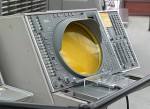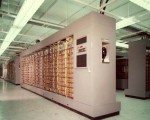The Second World War demonstrated the devastation that could be caused by even conventional bombing…and was capped by the nuclear destruction of Hiroshima and Nagasaki. With the intensification of the Cold War and the first Soviet atomic bomb test…and the Communist aggressiveness demonstrated by the outbreak of war in Korea…air defense of the United States became an issue of very high priority.
During World War II, the British had been successful with their innovative network of radar stations linked to command centers at which the positions of friendly and enemy aircraft were plotted continuously and orders issued to fighter squadrons and antiaircraft gun sites. In the postwar era, though, the increased speeds of combat aircraft, combined with the utter devastation that could result from a single failed intercept–one plane, one bomb, one city–drove the view that something better than manual plotting would be required.
Although digital computers were still very much in their infancy in 1953, the solution to the air defense problem chosen in that year was a computer-based system to be known as SAGE…the Semi-Automatic Ground Environment. Real-time information from multiple radar sites flowed in digital form to the computers at the SAGE Direction Centers. The computers tracked the targets, friendly, unknown, and enemy, and displayed them on dozens of video displays at each Center. Battle-management personnel at these displays made the determination of which enemy targets should be engaged with what priority, and what friendly aircraft should engage them, and the computers then calculated the optimum intercept courses. For certain fighter aircraft types, the interception commands could be relayed directly via datalink, obviating the necessity for voice communication. SAGE Direction Centers also had control over high-speed BOMARC antiaircraft missiles…these carried small nuclear weapons intended to ensure that a near miss would not allow enemy bombers to escape.
At the heart of each Direction Center was a pair of computers, AN/FSQ-7, duplexed for reliability. Each pair contained fifty thousand vacuum tubes, covered almost an acre of floor space, and consumed about 3 megawatts of power. (Some sources cite the 50,000-tube number as being for each computer of the pair–either way, it’s a LOT of vacuum tubes.) Here’s a fairly well-done recent article about the SAGE project. Note, however, the author’s comment about “thousands of people all over North America constantly scanning their radar screens for Soviet attacks, all hankering for an opportunity to launch a radio-controlled nuke.” I wonder: does this guy really believe that the airmen at the SAGE scopes were really looking forward to a nuclear war, or did he just think that’s the sort of thing that would play well with his editors and his audience?
Developing the hardware required for SAGE was a challenge; developing the software even more so. IBM’s Tom Watson Jr explained the issue: “In those days computing was typically done in what was called batch mode. This meant that you would collect your data first, feed it into the machine second, then sit back for a little while until the answer came out. You could think of the batch processor as a high diver at a circus–each performance involves a lengthy drum roll in preparation, a very fast dive, and then a splash. But the SAGE system was supposed to keep track of a large air defense picture that was changing every instant. That meant it had to take a constant stream of new radar information and digest it continually in what is called “real time.” So a SAGE computer was more like a juggler who has to keep a half dozen balls in the air, constantly throwing aside old balls as his assistant toss him new ones from every direction.”
Read more


